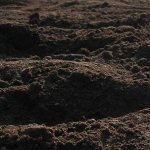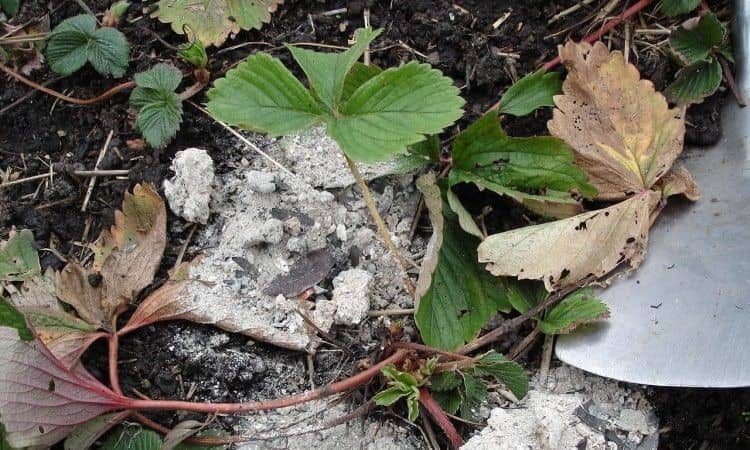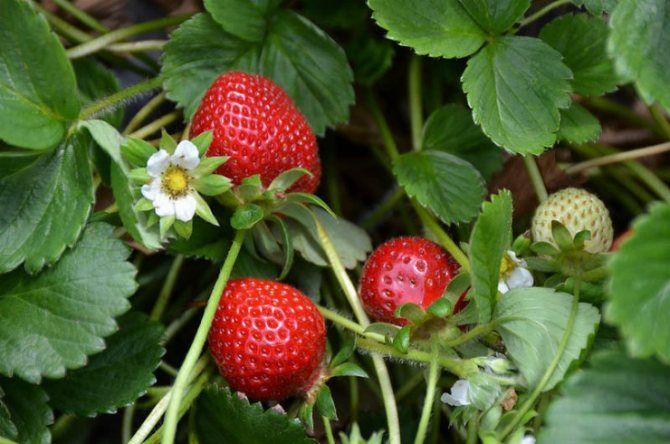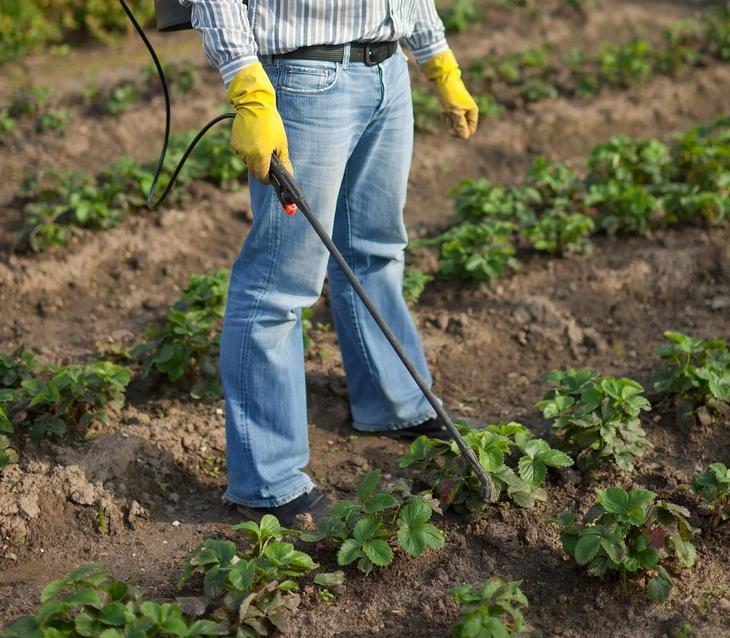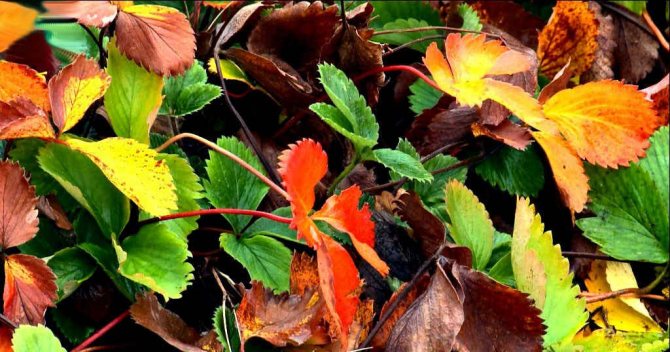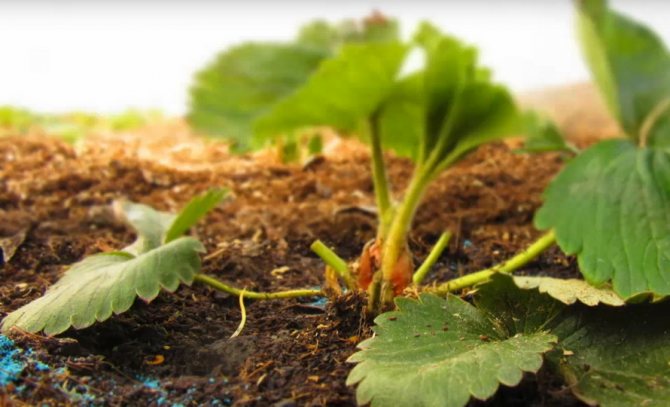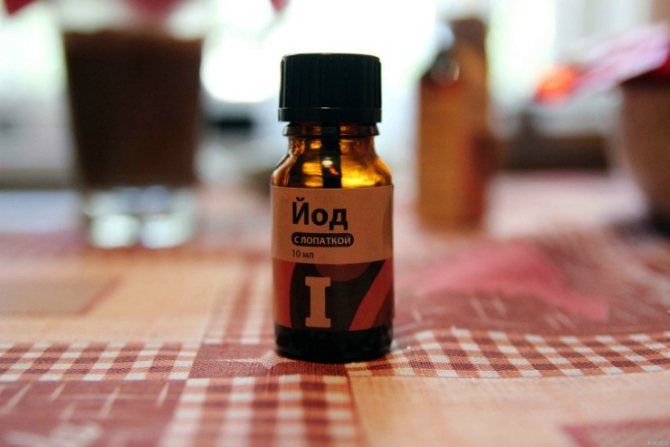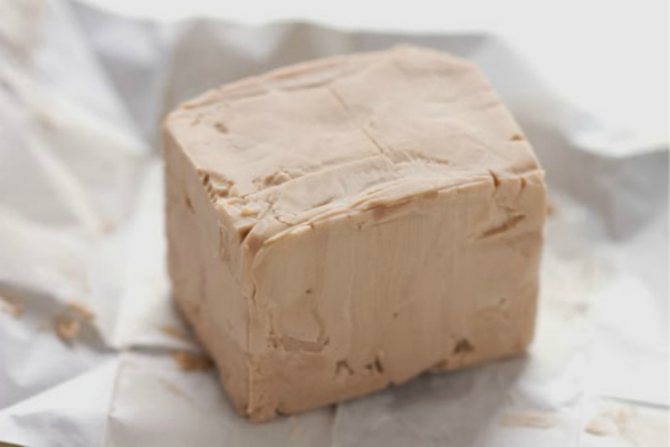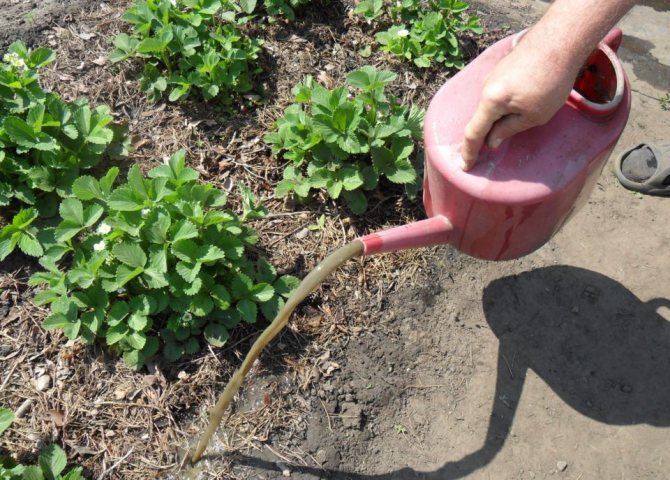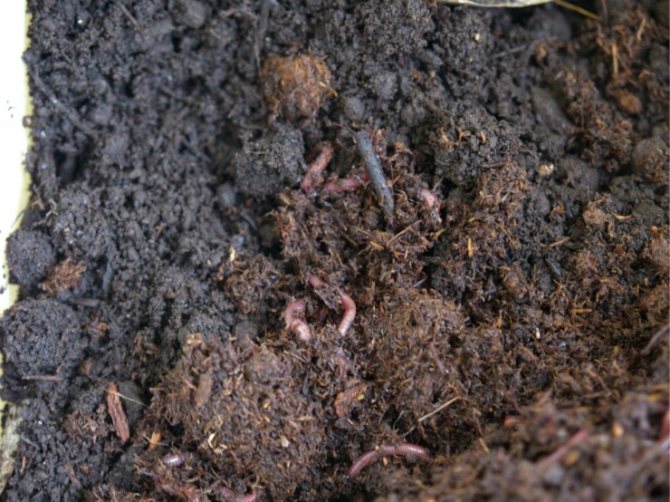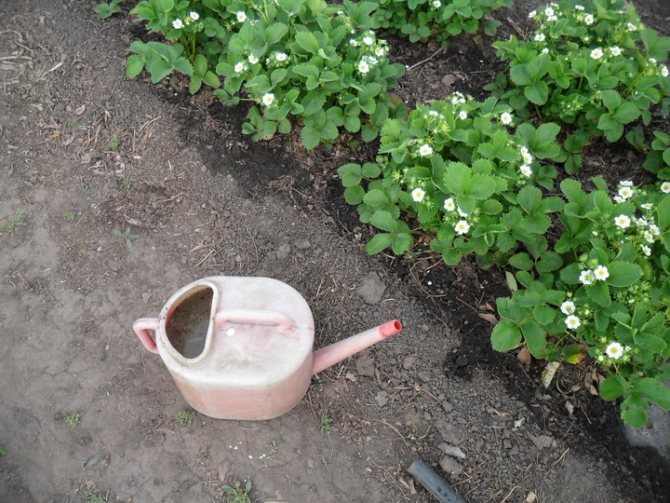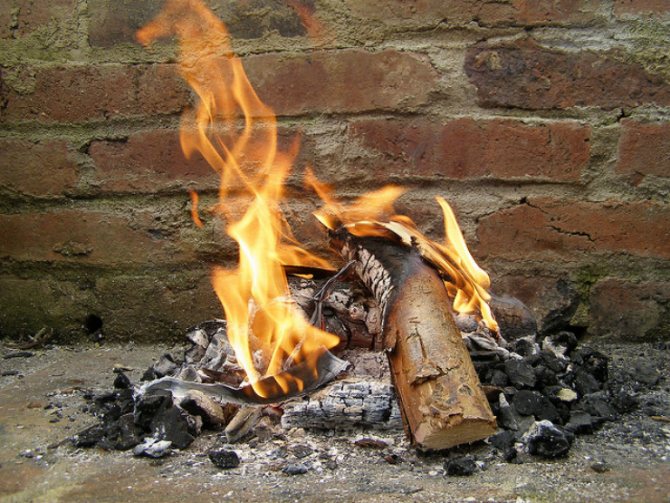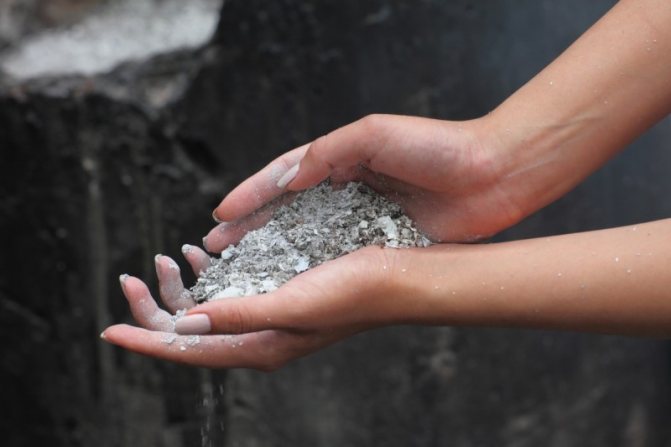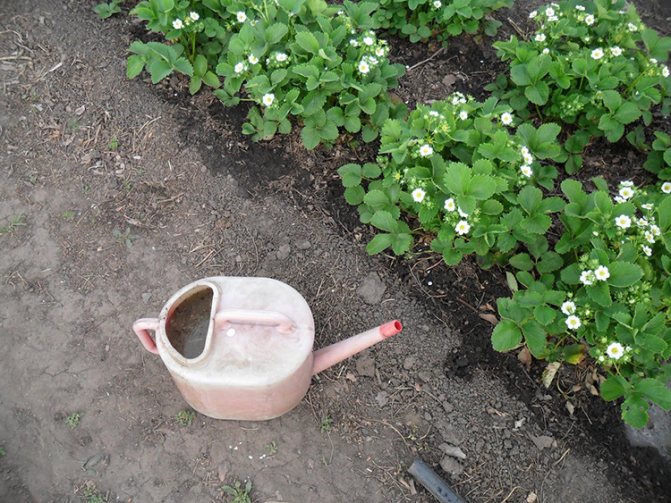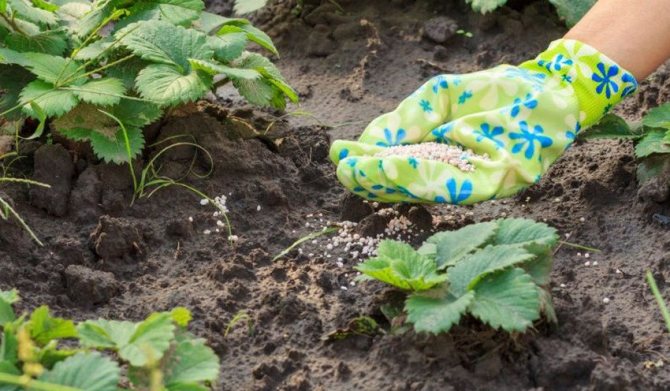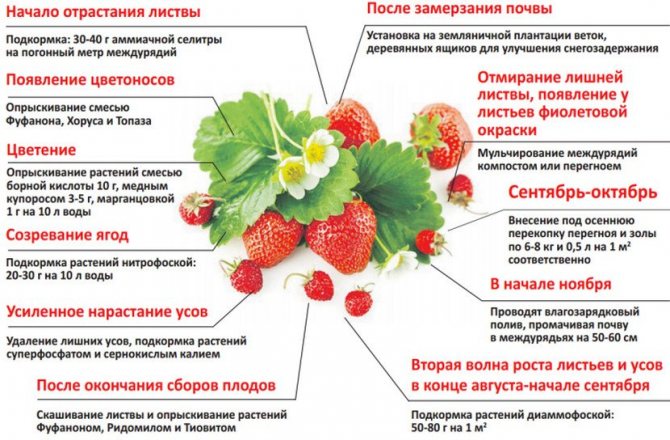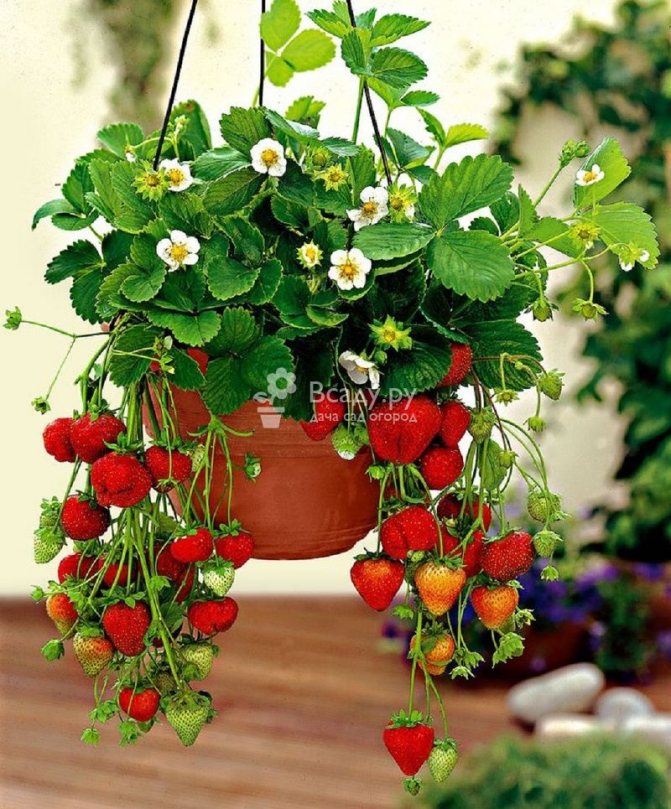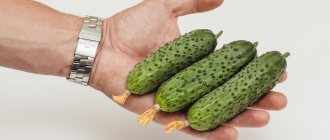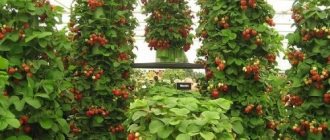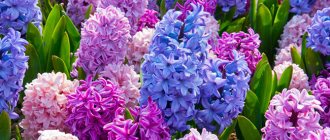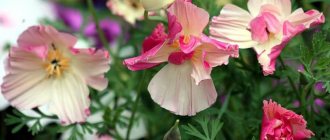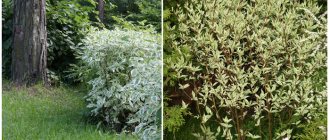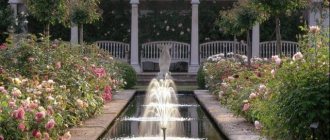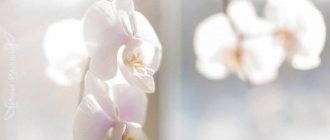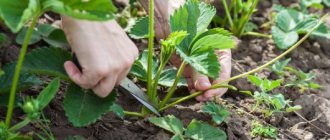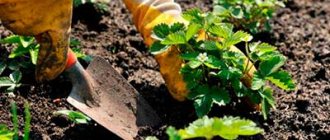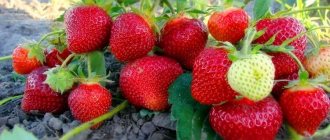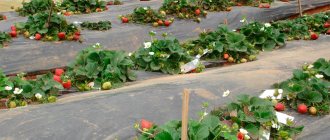Strawberries are one of the first berries to ripen in the garden. Of course, the abundance of the crop does not depend on one factor; it is influenced by the selected variety, the quality of the soil, and weather conditions. But the nutritional value of the substrate is one of the prerequisites.
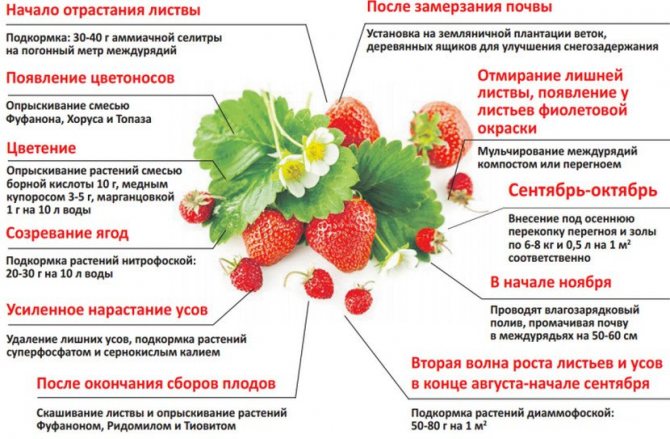
Strawberries are transplanted every four years, rejuvenating the bushes, as the soil is depleted during this time. In the first year after planting, there is no need to fertilize strawberries, since certain fertilizers are already being applied during planting (for 1 square meter of land we add 2 tablespoons of nitrophosphate, and when preparing the beds in the fall, 1 glass of wood ash and 2 glasses of dolomite flour).
Therefore, the first year after planting-transplanting, the soil is only mulched with the addition of rotted sawdust and sand, since strawberries love loose soil.
In the second year, at the end of April, beginning of May, when we start caring for strawberries: to clear the ground of dry, old leaves, loosen the soil between the bushes, we also mulch the soil around each bush and add organic matter: humus, sawdust, needles or moss. It is very important to fertilize strawberry bushes with humus (organic matter) in the spring, before flowering.
Humus is completely decomposed manure (looks loose and dark) and already contains essential nutrients in a form that can be easily absorbed by plants. And sawdust, needles and moss will turn into humus only over time. If there is no humus, but only manure, you can carry out the following top dressing: for 10 liters of water, 1 tablespoon of ammonium sulfate and a half liter jar of mullein. We use the prepared solution 1 liter for each strawberry bush.
After picking berries for feeding (in order to harvest the best harvest next year), you can use complex fertilizers - nitrophoska (1 tablespoon per 10 liters of water), nitroammofoska, or another complex mixture.
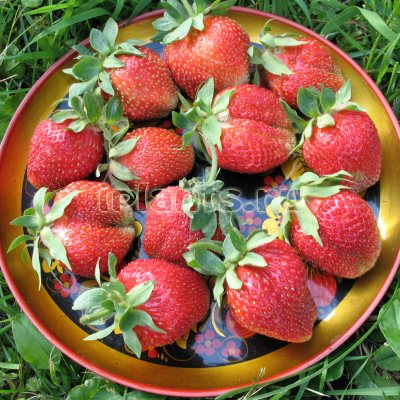

We feed the plants of the third year of growth only with mineral fertilizers. At the end of May, before flowering, you can carry out the following top dressing: dilute 1 teaspoon of potassium sulfate and 2 tablespoons of nitrophoska in 10 liters of water, use the resulting solution half a liter under each bush. After harvesting and trimming old leaves, you can feed with such a complex fertilizer: 2 tablespoons of nitroammophoska and 1 glass of ash per 10 liters of water.
Feeding strawberries
Strawberries are one of the first berries to ripen in the garden. Of course, the abundance of the crop does not depend on one factor; it is influenced by the selected variety, the quality of the soil, and weather conditions. But the nutritional value of the substrate is one of the prerequisites.
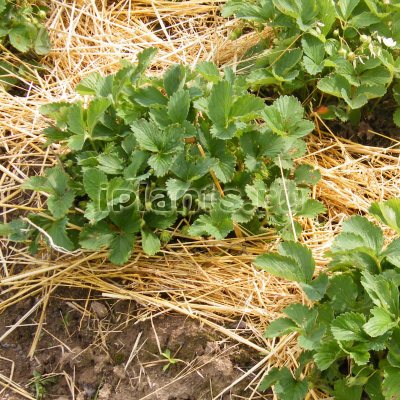

Strawberries are transplanted every four years, rejuvenating the bushes, as the soil is depleted during this time. In the first year after planting, there is no need to fertilize strawberries, since certain fertilizers are already being applied during planting (for 1 square meter of land we add 2 tablespoons of nitrophosphate, and when preparing the beds in the fall, 1 glass of wood ash and 2 glasses of dolomite flour).
Therefore, the first year after planting-transplanting, the soil is only mulched with the addition of rotted sawdust and sand, since strawberries love loose soil.
In the second year, at the end of April, beginning of May, when we start caring for strawberries: to clear the ground of dry, old leaves, loosen the soil between the bushes, we also mulch the soil around each bush and add organic matter: humus, sawdust, needles or moss.It is very important to fertilize strawberry bushes with humus (organic matter) in the spring, before flowering.
Humus is completely decomposed manure (looks loose and dark) and already contains essential nutrients in a form that can be easily absorbed by plants. And sawdust, needles and moss will turn into humus only over time. If there is no humus, but only manure, you can carry out the following top dressing: for 10 liters of water, 1 tablespoon of ammonium sulfate and a half liter jar of mullein. We use the prepared solution 1 liter for each strawberry bush.
After picking berries for feeding (in order to harvest the best harvest next year), you can use complex fertilizers - nitrophoska (1 tablespoon per 10 liters of water), nitroammofoska, or another complex mixture.
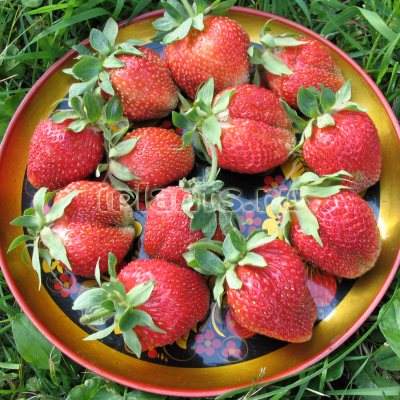

We feed the plants of the third year of growth only with mineral fertilizers. At the end of May, before flowering, you can carry out the following top dressing: dilute 1 teaspoon of potassium sulfate and 2 tablespoons of nitrophoska in 10 liters of water, use the resulting solution half a liter under each bush. After harvesting and trimming old leaves, you can feed with such a complex fertilizer: 2 tablespoons of nitroammophoska and 1 glass of ash per 10 liters of water.
Fertilizer when planting
Experts advise to prepare the soil for planting at least a month in advance. The earth must stand, soften the concentration of the fertilizers applied, so that the roots of the seedlings are not burned.
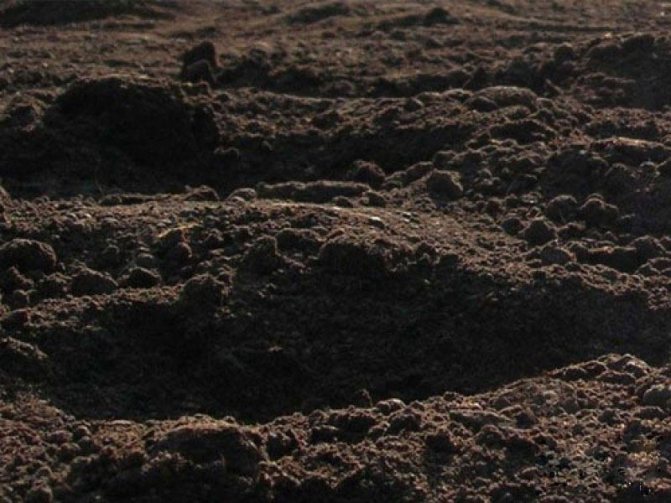

Before planting, the soil must be fertilized in advance.
Usually, amateur farmers are divided into those who use chemical fertilizers and those who do not accept it.... The first ones study the experience of Oktyabrina Ganichkina and Galina Kizima, calmly introduce multi-colored granules into the ground and dilute powders from sachets according to the instructions. The latter prefer the methods of Nikolai Kurdyumov and Pavel Trannoy, compost, mulch and save themselves from all troubles with ashes. It is clear that everyone will "feed" their plants accordingly.
| Chemical fertilizers | Organic fertilizers |
| Option 1 1 tablespoon of superphosphate + half a teaspoon of chlorine-free potassium fertilizer (potassium sulfate) per running meter of planting | Option 1 Half a glass of ash per running meter of planting |
| Option 2 One and a half teaspoons of ready-made fertilizer containing phosphorus and potassium (for example: Gera, Fasco, Rubin (Spring-Summer), Buisk fertilizers) per meter of plantings. Close up in the soil with a flat cutter or a hoe, well spill! | Option 2 Ash + compost (or ripe manure) + dry coal (it will absorb nitrogen and potassium from humus and slowly decompose, it will feed the plant) |
Microfertilizers in chelated form
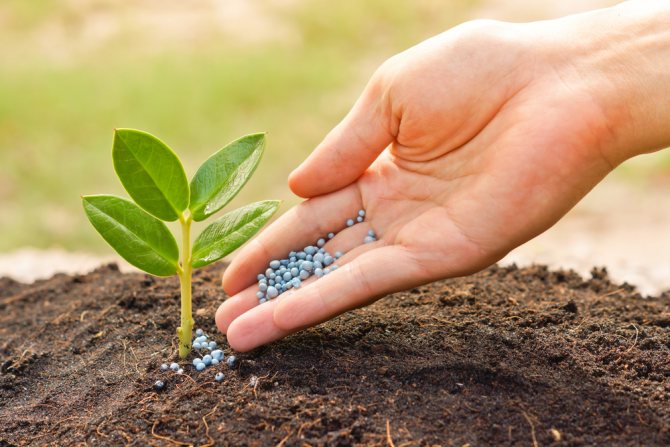

Chelated fertilizers are ecological safe
However, there are modern fertilizers that are able to suit and reconcile all farmers, since they are both environmentally friendly and efficient. These are chelated fertilizers. Scientific research confirms that chelates are ten times more effective and safe than phosphate and sulfate concentrates.
Chelates are compounds of metal ions with amino acids. The organic molecule seems to capture the metal in a "claw", the cell perceives this compound as related, assimilates the metal ion, and the chelate breaks down into simple substances. For example, vitamin B12 and chlorophyll are also chelates. Today on sale you can find chelated fertilizers Kristalen (Norway), Master (Italy), Aquarin (Buisk chemical plant, Russia), Vuksal (Germany). So far, chelated fertilizers have only two drawbacks - the high price and, as a result, a large percentage of fakes.
Folk agronomy
People's love for strawberries has invented many ways to fertilize them with available substances. The berry is fertilized with yeast, iodine, infusions of herbs, black bread and onion husks... Efficiency, as in traditional medicine: it can help, maybe not, but it will not cause serious harm to either the plant or the wallet.
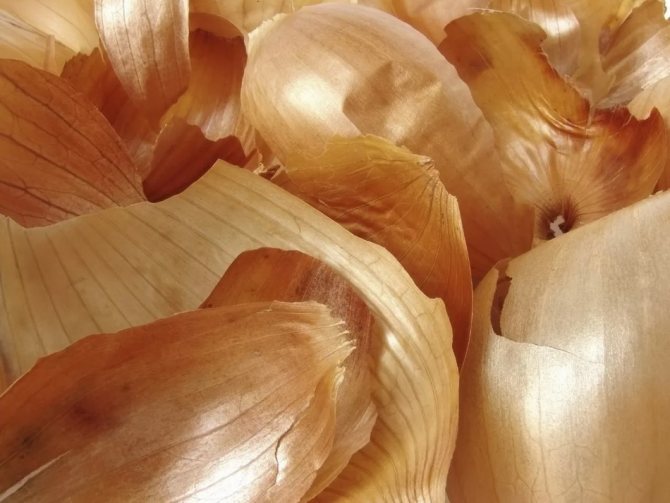

Onion peels - nourish and protect
Information about such methods lives mainly on the Internet; there is nothing like that in the books of famous authors. I once tried top dressing with yeast on my strawberries. I did not see a noticeable effect, except that the soil was covered with a dense crust, I had to additionally loosen it. But for the sake of entertainment and out of respect for the positive experience of other farmers, I will tell you about these methods.
| fertilizer | benefit | method of introduction |
| Yeast | Contains protein, carbohydrates, fats, nitrogen, potassium and phosphorus | Dissolve 50 g of pressed or 1 teaspoon of dry yeast in 1 liter of warm water with 1 teaspoon of sugar, after 2 hours dilute with water 1: 5. You can fertilize 3 times: during the buds, green berries and after harvesting in warm weather. |
| Black bread | Similar to yeast, in fact, it's all about | 1/3 bucket of crackers in a bucket of water, leave to ferment in a warm place, then strain, add 2 liters per bucket of water |
| Iodine | The antiseptic may suppress the growth of fungi, but there is no reliable research on this topic. Moreover, iodine vapors are poisonous to humans, and the fungus spreads its spores nearby everywhere, including in the soil, so does it make sense to spray the leaves? If we talk about nutrition, it is better to add iodine as part of complex fertilizers. There it is in an accessible form and in the right amount. | Dissolve 15 drops of iodine in a glass of whey or milk in a bucket of water. |
| Onion peel | Contains carotene (antioxidant, stimulates the immune system, destroys fungi and rot), phytoncides, vitamins B, PP. Improves the tone and growth of plants. | 1 glass of husk (fill tightly) pour 3 liters of boiling water, leave for two days, drain. Dilute 1: 2 with water before use. You can pour it at the root and spray it. |
Feeding strawberries with ash
In general, wood ash is very often used to fertilize strawberries and strawberries. Ash is a potassium-phosphorus-lime fertilizer with a complex of microelements. A handful of ash can be applied under a strawberry bush (or rather, in the aisles) twice a season - in spring with soil mulching, and after fruiting and pruning the bushes. Dry ash is always applied before rain or before watering.
Some gardeners prefer to apply ash not dry, but in solution. To do this, one glass of ash is poured into 1 liter of hot water and left to brew for a day. Then add another 9 liters of water, bringing the total volume to 10 liters. Everything is thoroughly mixed, used for watering at the rate of 1 liter of solution per 1 sq. m of the ridge.
Complex fertilizer "Ryazanochka"
Ready-made feeding for strawberries "Ryazanochka" is very popular among gardeners. It contains micro- and macroelements (nitrogen, manganese, phosphorus, zinc, copper, potassium, boron, molybdenum, cobalt). For root feeding, a solution should be prepared at the rate of 1 teaspoon of Ryazanochka (4 g) per 10 liters of water. The plant must be fed in the morning and evening.
The finished product is consumed depending on the period of development of the berry culture. So, at the beginning of the vegetative development of strawberries, the solution is watered at the rate of 5 liters per 2-3 sq.m. area. When budding, at the beginning of flowering and active fruiting of the berry, 10 liters of the product are spent on the same area. The last time the plant is “fed” 2–3 weeks before harvesting.
"Ryazanochka" can be used by the foliar method. Only in this case, the solution is prepared differently: ½ teaspoon (2 g) is added to 10 liters of water. The resulting product is sprayed with berry culture in the morning and evening in cloudy, but not rainy weather twice during the summer season. The advantages of Ryazanochka include the following properties:
- a positive effect on the taste and external qualities of the fruit;
- increasing the yield of berry crops through the use of complex feeding;
- beneficial effect on disease resistance of the berry.
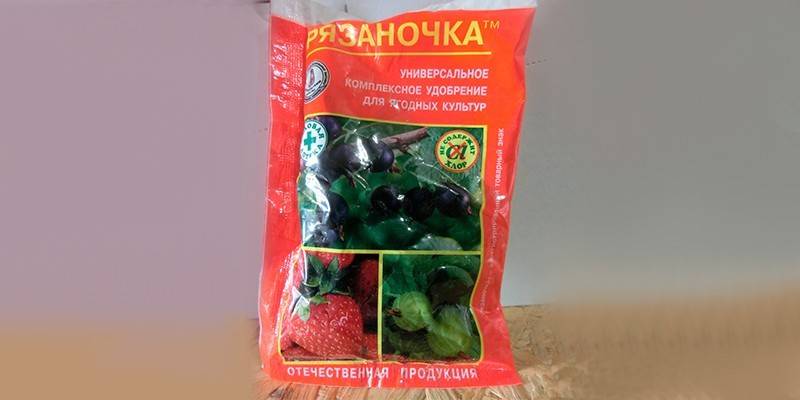

Foliar feeding of strawberries
Before flowering, you can carry out additional feeding with microelements important for garden strawberries: add 2 g of boric acid, 2 g of potassium permanganate, 1 glass of sifted ash, 1 tablespoon of iodine to a bucket of hot water. Let stand and all ingredients dissolve. The water temperature should be around 65 ° C. Spray strawberry bushes (strawberry), but not in direct sun, but in the late afternoon or morning.
The main thing is to know that strawberries and strawberries do not tolerate the presence of chlorine in fertilizers. It is also very important not to overfeed the strawberries, otherwise, instead of a bountiful harvest of berries, you will only grow lush bushes of greenery. And overfeeding occurs usually due to excessive or frequent application of organic matter (there is a lot of nitrogen in it), some gardeners like to use mullein, chicken manure or horse manure. If this happened to you and the strawberry has healed - it has grown powerful beautiful leaves, but almost did not bloom, stop feeding and do not resume the next year.
Composition and benefits
Wood ash is a natural easily digestible product, the composition of which is represented by potassium, calcium, phosphorus, manganese, iron, magnesium, boron, molybdenum and many other trace elements necessary for normal plant growth. The only element that is vital for the development of strawberries, and is not present in the ash, is nitrogen.
This fact is explained by the physicochemical processes occurring during the combustion of wood, as a result of which the decomposition and volatilization of nitrogen occurs. This does not allow the use of wood ash as the only fertilizer and presupposes the use of nitrogen-containing preparations.
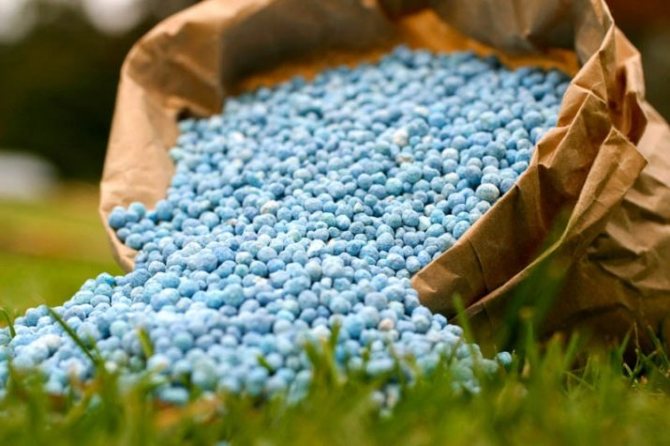

The simultaneous use of nitrogenous fertilizers and ash is prohibited. The fact is that when these components are mixed, a chemical reaction occurs, as a result of which ammonia is formed. Strawberries tolerate its presence rather poorly and can respond with a significant slowdown in growth and a significant drop in yield. Therefore, nitrogen and ash should be applied at intervals of at least two weeks.
Wood ash is able to lower the acidity level on acidified and highly acidified soils. However, in areas with normal acidity and an alkaline environment, the use of ash can prevent plants from fully absorbing nutrients.
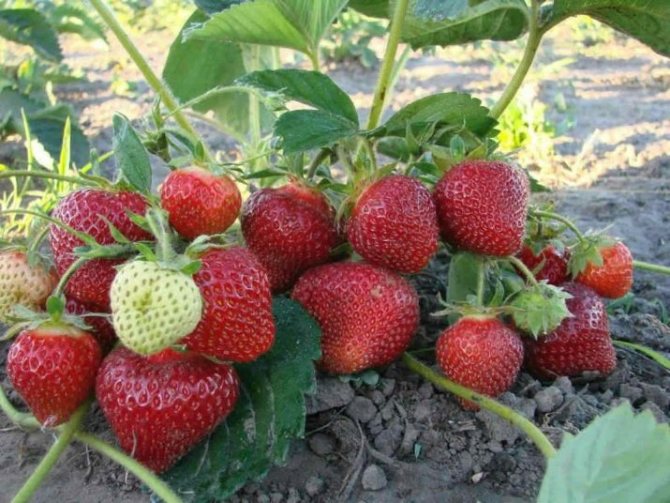

The acidity of the soil can be determined independently: for this you need to inspect the plants that grow on the site. If nettle, clover, wheatgrass, alfalfa, burdock and field bindweed predominate among the weeds, then the soil is alkaline.
The presence of acidified soils will be evidenced by such plants as horse sorrel, sedge, creeping buttercup, poplar, field horsetail, Veronica oakwood, woodlice, mint and plantain. They love acidic environments and always grow in such areas. Wood fertilizer has a rather beneficial effect on the culture. It enhances plant immunity, helps fight insect pests and nourishes strawberry roots with essential elements.
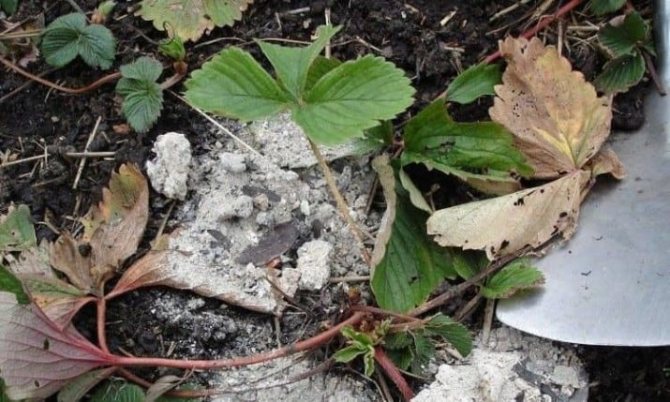

Advantages and disadvantages
A large number of positive reviews about the use of wood ash as a top dressing is due to a number of indisputable advantages of this fertilizer.
- Trace elements contained in the ash are very easily and quickly absorbed by plant roots. This is due to the natural origin of the feeding and the absence of hard-to-digest components.
- A large number of nutrients almost completely satisfies the needs of strawberries in the necessary chemical compounds. Properly prepared ash can easily compete with cow dung in its benefits. The main key to success is the process of its manufacture, which involves burning clean wood, without paint and varnish admixtures, nails and debris.
- Wide availability fertilizer is due to ease of manufacture and minimal cost.
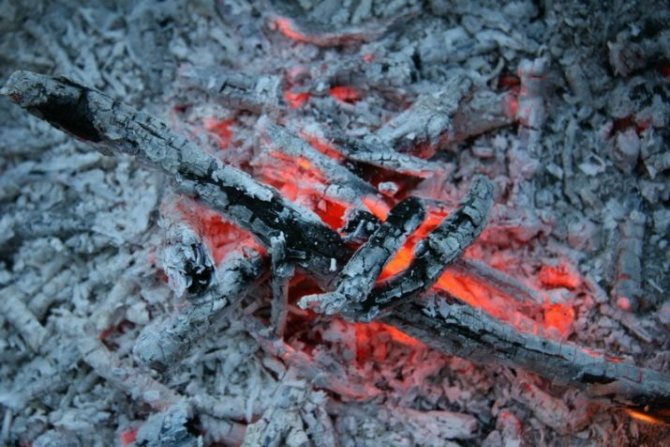

- Long shelf life. Wood ash does not lose its nutritional value for 4 years. The only condition for storing the drug is a tightly closed container. Otherwise, the fertilizer can saturate moisture and lose its beneficial qualities.
- Fast and lasting effect. Changes in the appearance of berries after the use of ash fertilizers become noticeable very soon. The fruits become much larger and more flavorful, last longer after harvest and become immune to gray mold. In addition, many strawberry pests bypass the treated bushes. This is especially true of the raspberry-strawberry weevil, the invasion of which can lead to a decrease in productivity, and sometimes the death of especially weakened plants.
- Ash-treated bushes much easier to tolerate moisture deficiency and form significantly more fruit.
The disadvantages of wood ash include the impossibility of using it on alkaline soils and the absence of nitrogen in the composition.
However, the second factor can be easily eliminated by the additional introduction of nitrogen-containing preparations.
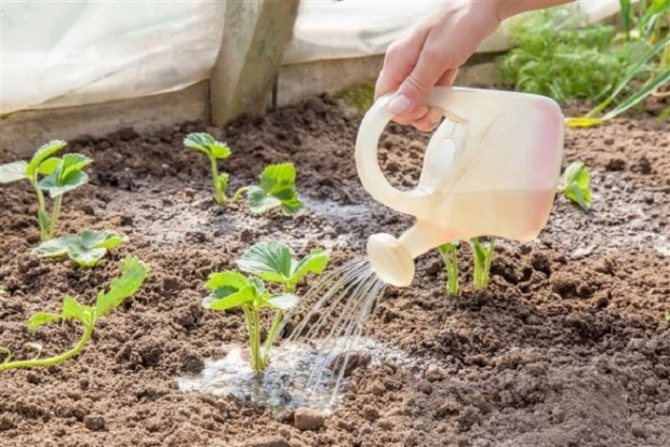

Application features
Feeding strawberries with ash additives is carried out at different times. The timing of fertilization depends on the type of soil on which the crop is growing. So, in sandy loam and peat soils, fertilizers are applied in the spring, while in clay and heavy soils - in the fall. The amount of additives is also calculated individually, and depends on the area of the strawberry plantations and their purpose.
For example, for growing berries for sale, you will need a little more ash than for growing for your own needs. This is due to the need to ensure the presentation of the fruit, as well as large areas of industrial planting. One or two buckets will be enough for your own plot, while commercial cultivation per hectare of area will require up to 15 kg of fertilizer.
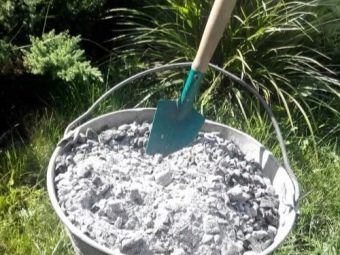

Some gardeners, instead of pure ash, use a universal ready-made fertilizer based on it. A glass of such a product is diluted in a bucket of water, after which each bush is fed at the root. Good results are obtained by alternating such a solution with chicken dung, or saturating the compost with it. This allows beneficial microorganisms to multiply quickly, which significantly increases the nutritional value of the latter.
Feeding strawberries with ash fertilizer can be done in two ways. The first is to sprinkle the row spacing with dry dressing. Moreover, many summer residents are not limited only to the space adjacent to the bush, but dust the entire plant with ash.
The amount of fertilizer per bush should not exceed 15 g for the first feeding, and 7-8 g for the subsequent ones.
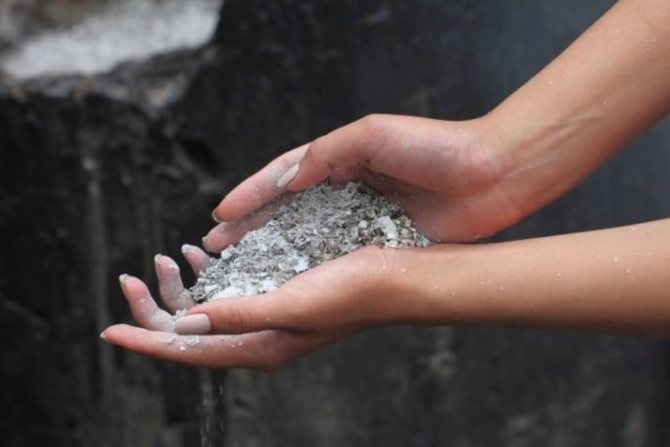

Some novice gardeners are somewhat confused by the sight of strawberries sprinkled with ash. However, there is no reason for concern here: at the first rain or watering, it will wash off and mix with the ground. In addition, dusting repels pests, so at the first signs of insect damage to plants, you should immediately sprinkle the bushes with ash. When applying dry fertilizer directly under the bush, it is recommended to loosen the soil a little, mixing it with ash, and then water the plantation.
The second way is to prepare a solution. To do this, you need to dissolve a glass of ash in one liter of hot water and put it in a warm place for a day. Then pour the contents of the jar into a ten-liter bucket and stir well.
Plants are processed at the rate of one liter per square meter.
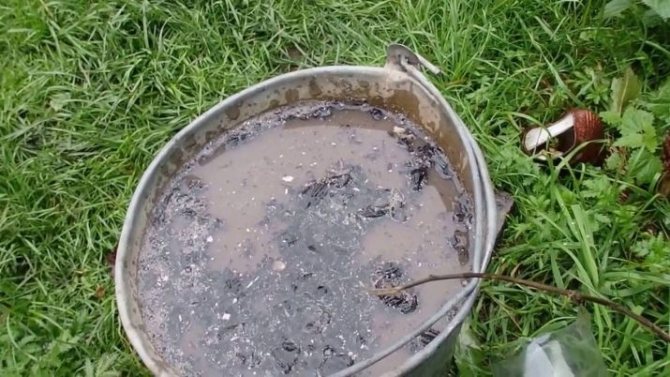

How to fertilize strawberries in spring
In order to enjoy sweet and fragrant strawberries in season, it is sometimes necessary to resort to feeding. In this article, we will tell you when and how to feed it for good growth and a high yield (Figure 1).
First of all, you should decide how to feed strawberries in the spring for a better harvest. Traditionally, both organic and mineral products are used for this, but they should be applied in accordance with certain rules.
Advice
The first feeding is carried out as soon as the snow has melted and the weather is warm. It is necessary to stimulate the growth of young shoots and leaves, therefore, substances containing nitrogen should be used.
Note: First of all, you need to loosen the soil and cut off the dry leaves, then feed.
The bushes of the first year of life are not fed, since fertilizers are applied under them when planting. But a two-year culture especially needs feeding. The first begins when the first leaves appear around mid-April. During this procedure, a mullein is added to the plant or replaced with chicken droppings.
During the second feeding, during flowering, the bushes are fed with mineral preparations. The last feeding can be done with weed infusion. To do this, weeds are removed from the beds, crushed, poured with water and insisted in a warm place for a week.


Figure 1. Methods for feeding strawberries
Foliar top dressing can also be carried out in the spring. It is carried out by spraying plants with a solution of nitrogen or organic matter. Thus, all nutrients are absorbed immediately, positively affecting the growth of the bush and the number of ovaries. Such a procedure is carried out on a dry, windless day and better in the evening.
Recommendations
It is necessary to fertilize plantings in spring based on your location, the further south your region is, the earlier we begin to carry out the procedure. In areas with a warm climate and mild winters, this is done in mid-April. For northern areas - mid-May.
For fertilization to benefit the plants, it is important to know the flowering time of the varieties that grow in your area. This is necessary, since with early application, useful substances will go into the ground, and during flowering, the bushes will not get anything valuable. Conversely, if feeding is carried out later than necessary, we risk getting a meager harvest. It is also important not to overdo it with nutrients, as this can negatively affect the plants.
It is better to use chicken manure in the spring and only once a year. When watering plants, the liquid should not get on the bush itself.
You will find useful tips for carrying out the first spring feeding of strawberries in the video.
Fertilization timing
Fertilize strawberries with wood ash three times per season. The first time feeding is carried out in early spring, and is done when loosening a strawberry bed. Together with ash additives, nitroammophoska and bird droppings can be added. This will stimulate leaf growth and improve the overall health of the shoots. The second time feeding the strawberries is done after the harvest.
During this period, the active formation of new buds and roots begins, and the preparation of the plant for winter. The harvest of the next year will depend on the number of buds formed, therefore fertilization at this stage is the most important and decisive. The third time the treatment of the site is carried out before the onset of cold weather. The ash is scattered around the bushes and, with the help of loosening, is mixed with the soil.
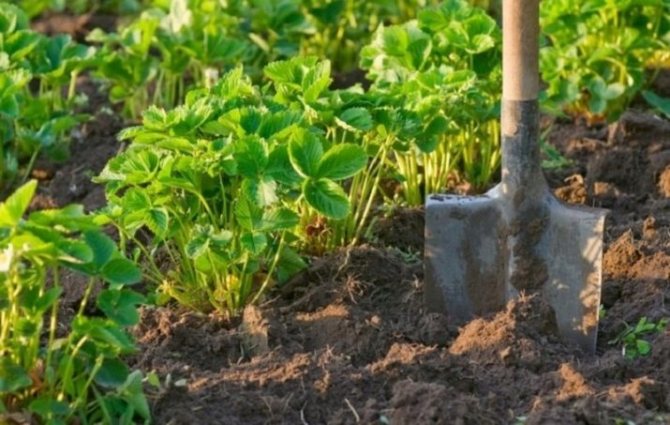

It should be noted that fertilization with wood ash during flowering and fruiting of strawberries is not used.
During this period, you can feed the plants with additives containing boric acid, potassium sulfide and potassium permanganate. In the event of the appearance of fungal diseases, experienced gardeners are advised to dilute metronidazole at the rate of 2 tablets per liter of water, and spray the leaves.
Using wood ash as a fertilizer for strawberries has been shown to work well. Plants acquire resistance to fungal diseases and get rid of pests, and berries acquire a juicier taste and become larger.Thanks to this, an increasing number of summer residents prefer ash, and replace it with chemical fertilizers.
For information on how to properly use ash as fertilizer, see the next video.
When to fertilize strawberries
It is necessary to feed strawberries during the growing season 3 times. The first will be needed in the spring, the second - after harvesting, the last - during preparation for winter. When the strawberries begin to dissolve the leaves, the wood ash is poured under the bush and the soil is carefully loosened. Supplemented bushes develop better, and they develop shoots faster.
Spraying of bushes is often used during flowering. Use preparations containing boron and zinc. When the strawberry berries are harvested, they are fed a second time. The latter is necessary to stimulate the formation of new roots and leaves. This happens during the preparation for winter.
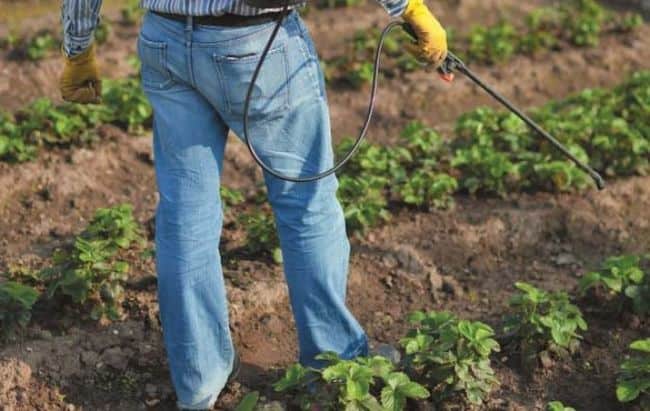

Did you know! For top dressing, only wood ash is taken. Remaining after incineration of garbage or household waste is not used.
What is the benefit?
With the help of this type of dressing, you can notice several positive points at once:
- ash as a top dressing is considered a natural component that helps the growth and development of the berry;
- the top dressing contains a large amount of nutrients that are vital for the plant. Sneezers include magnesium, iron, and phosphorus;
- with the help of feeding, you can achieve a better result in matters of strawberry care than from expensive analogues.
The only nuance that can spoil the crop is the combined use of ash and nitrogenous fertilizers. During their synthesis, ammonia is formed, which is destructive for this culture.
Also, the advantage of this fertilizer is a long service life due to its natural composition. Top dressing must be stored in an airtight package, otherwise, due to moisture, it risks losing its medicinal properties.
Advice! If the acidity of the common soil of the site is increased, you can neutralize it with wood ash. But if the soil is alkaline on the site, the ash can harm the strawberries and the crop as a whole.
Varieties of dressings and fertilizers
Preparations for the new growing season should take place in advance. In 65% of cases, gardeners collect seed from summer, autumn, and fertilizers (if they are organic) throughout the year. In winter, you can only buy mineral and complex formulations.
The need for early collection of fertilizers is associated with their introduction in due time. This will help the formation of buds, the rapid awakening and development of the plant.
It is worth remembering that the fertility of the land largely depends on caring for it and regular feeding. Indeed, in one year, the soil is quickly depleted when densely planted with crops.
As for strawberries, you need to feed them regularly, according to the recommended schemes. The plant is perennial. Therefore, its annual development depends on the quantity and correct selection of mixtures and substances.
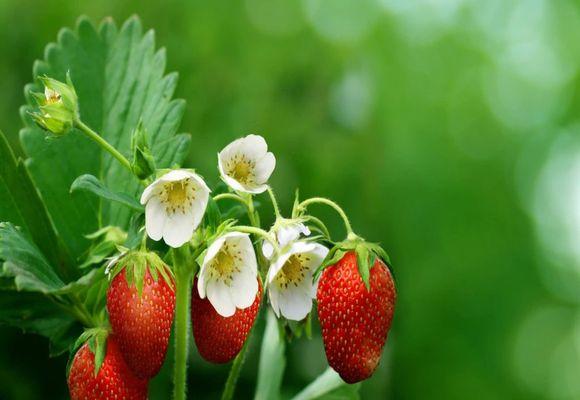

Mineral
Developments obtained in laboratory conditions with the help of synthetic substances - mineral fertilizing. They can have a complex effect, act as monopreparations.
Both types are in demand, since a separate nitrogen substance or potassium agents help at a certain stage of development. Complexes are more suitable for single feeding of strawberries.
Deserved popularity:
- diammophos;
- all types of sulfates;
- urea and saltpeter.
The nuances of using ash
Despite the seeming ease of use, there are a number of specific nuances that are recommended to be adhered to. When wondering how to feed strawberries with ash in autumn, it is recommended to pay attention to a number of the following factors.
The first thing to consider is the timing of top dressing. Fertilization of strawberries with ash is carried out at different times, depending on climatic conditions and soil composition.If the soil is sandy loam or peaty, this type of top dressing is recommended only in the spring season. Feeding strawberries in autumn is feasible in the presence of clay soil.
The amount of ash is not difficult to determine. It depends on the total area of the berry plantation. If the area is small, you will need about 2 buckets of fertilizer. If the area is 1 hectare or more, then 15 kg of fertilizer and more are used. In this case, the season does not matter. These proportions can be used for strawberries in August in the fall and early spring.
Preparing the nutrient solution
Sometimes for the berry it is necessary to use not a dry fertilizer, but its solution. Under strawberries in the fall, you can use such a solution for any type of soil. To prepare it you will need:
Dilute the indicated ingredients until completely dissolved. Ashes for feeding in this form are used by watering each berry shrub under the root. It is worth knowing that ash in the same form is used for composting. With its help, feeding strawberries after fruiting will be especially effective.
How to feed garden strawberries: ways
The culture blooms in April, but the exact dates are determined by the variety, the climatic conditions of the region. Varieties of strawberries of a neutral day lay buds for 7-8 weeks, surprising with lush flowering and abundant fruiting throughout the season. The berries are tied almost until autumn. Therefore, the gardener needs to take into account the characteristics of the plant by planning the schedule, methods and types of fertilizing.


During bud formation and flowering, strawberries are fed:
- under the root;
- on the sheet (spraying).
The first ones are brought under the bushes, trying not to get solutions on the leaves, shoots, flowers and ovaries. Nutrition enters through the roots of the plants.
Foliar spraying is carried out on the sheet. The concentration of solutions is less, while most often feeding is carried out in cloudy cool weather. On such days, strawberries absorb nutrition from the soil worse, therefore, to obtain the desired result, fertilizers are given on the leaves.
On a note! Experts recommend that you spray the underside of the leaf plates especially carefully. The absorption of solutions through this side is more intensive.
What is the time to fertilize?
During the growing season, it is recommended to treat the plant with the specified fertilizer at least three times. The first time fertilization is applied in the spring, the second time after fruiting and harvesting. Feeding strawberries with ash for the third time is carried out in the process of preparing berries for wintering.
Important! Many budding gardeners are wondering if non-wood-type ash can be used. The answer to this question is negative, since a different type of ash can have a detrimental effect on the berry. Only wood-type ash is suitable for creating fertilizers.
In the process of flowering, plants use spraying, which contains zinc with bromine in equal proportions. Processing strawberries in this way stimulates growth and strengthens resistance to garden diseases.
Why feed in the spring?
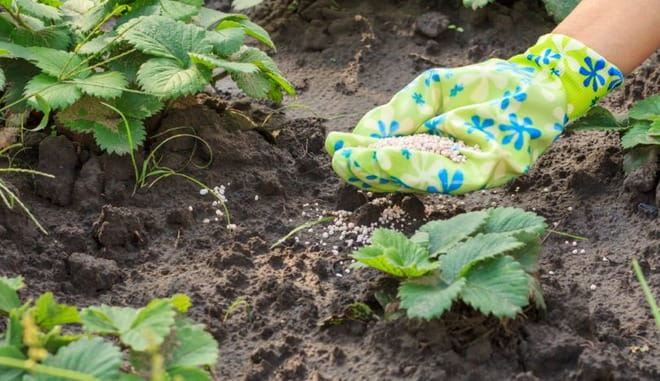

After prolonged cold weather, the berry needs additional feeding for better preservation and development. At this time of the year, nitrogenous fertilizers are used to feed strawberries. The main task of these fertilizers is to produce foliage, which is necessary for strawberries for further development. The berry also needs supplements containing potassium and phosphorus.
Gardeners recommend starting fertilizing the beds as soon as the last snow melts. For better heating of the soil, the beds are removed, including mulch. When using granular substances, they should be embedded in the ground.
Is it worth feeding during flowering?
The shrub consumes a huge amount of nutrients during flowering.Therefore, strawberry ash can be used as an addition to such types of fertilizers as:
- boric acid;
- potassium sulphide type;
- potassium permanganate solution.
The plant should be fertilized with preparations and ash after the first flowering. There are no exact dates, as they differ depending on the region where the plant is grown. However, the importance of timely feeding is relevant for any district. If you fertilize strawberries late, the harvest will be, but more scarce than originally expected.
Advice. With the correct use of fertilizers, you can achieve the effect of increasing the yield by at least 30%. For this, plants should be sprayed during the flowering period. In addition to increasing the yield, such a simple technique will provide an increase in the mass of fruits by one unit.
Preparatory work
In the spring, after the snow melts and the topsoil dries up, you need to prepare the planting of strawberries for all the work necessary for it. Initially, the plants are freed from winter shelter and remnants of dry foliage, then the soil is loosened, weeds and plant roots in the soil are removed.
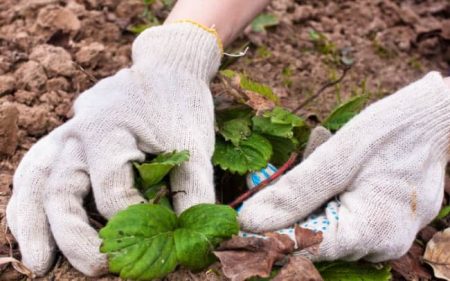

It is imperative to conduct a visual inspection of each bush - cut off dry leaves and tops, the neck of the strawberry should be 4-5 mm higher than the soil level (its deepening can lead to root rot).
Feeding strawberries during fruiting
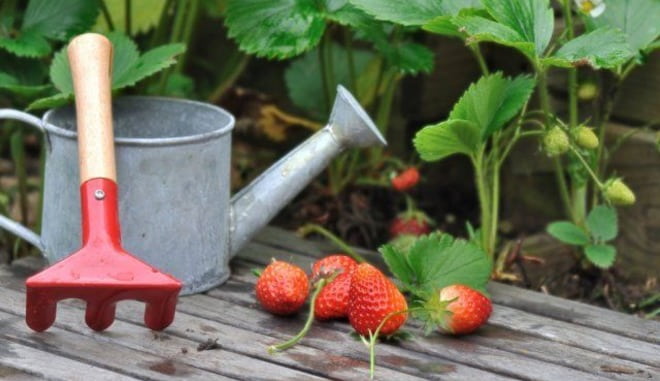

At this time, organic fertilizers are relevant. It has been noticed that almost any variety has the first harvest wave always the largest. After, the second or third time, the fruits do not appear so actively. Timely use of organic matter, such as compost or bird droppings, will help to avoid this effect.
Mullein can be used as an analogue. If you make a mistake and use other types of additives at this time, you can increase the content of nitrates in the berries, which will negatively affect the overall quality of the crop.
As you can see, the use of wood ash, both in pure form and as a supplement to other fertilizers, has an excellent effect on the quality of not only individual strawberries, but also the entire crop.

